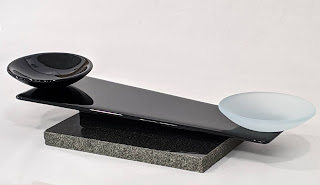Fused Glass Switch Plate Tutorial
 |
| Existing Off Center Switch Plate |
This past summer, a person I met at an outdoor art show
contacted me about creating a custom light switch for her home. She and her
husband had recently gone through a kitchen remodel. She explained that the
existing light switch was off-center (see photo, right), and she was looking for something to
appear more balanced in the space and work well with her existing décor. Would
I be interested? Well, sure, I thought. How hard can it be? That kind of
statement always ends up falling into the “famous last words” category.
While there are commercial fusing molds available for
various light switch configurations, they are, of course, all based on standard
flip switches, rocker switches, and outlet sets. The challenge with this
installation was that to balance the light switch visually on the wall, a commercial
mold could not be used.
 |
| Close-up of the existing switch plate |
I measured the wall and switches carefully, and along with
the client I concluded that a 5x10” piece would be suitable for the 18” space.
We also made the decision that she would replace the existing “old style” flip
switch with a more modern (and easier to work with!) rocker switch.
After working with the client to choose the glass, it was time to get to work. She chose a lovely piece of Spectrum's fusers reserve with blue, amber, and
white swirls on clear. I decided to use the flow of the glass to influence the
design. I would use the swirls in the fusers reserve to represent water, and
then create fused glass pebble embellishments. The base of the piece would be white.
The first step was to carefully draw the outline of the plate on cardstock and cut the base glass, and then cut and assemble with the fusers reserve and clear on top.
 |
| White base glass |
 |
| Layout of fusers reserve on base |
 |
| Into the kiln for a full fuse |
After fusing I checked the sizing of the switch and outlet
openings with a plastic switch plate I picked up at the local big-box hardware
store, and then later at a friend’s house who has double-rockers. I knew that
the glass would move some and I would need to make adjustments – these were
done with a small ¼” 100 grit diamond bit on my grinder.
 |
| Some of the pebbles were enhanced with reactive red |
Prior to the second fusing I visited the client’s house to
double check the fit. I had already done a test fuse on the “pebbles”with the initial firing, and brought a few of
those along so she could get an idea of what I was thinking. She was excited
with the design and loved the colors (which is always a relief!).
So that the switch plate would have an edge that rounded
down and sit flush on the wall, I placed it on a piece of 1/8” fiber paper for
the final firing. The fiber paper was cut just slightly smaller than the switch
plate, and I did not cut out the fiber paper for the rocker switch holes. This
firing was a tack fuse (almost a contour fuse), with a conservative annealing
schedule. My "cry factor" on this piece was pretty high (I didn’t want to do this
again!), so I annealed for two hours to ensure there would be no stress around the contour-fused pebbles. After this firing was completed, I used
the plastic switch plate as a template for the screw holes. To drill the holes,
I used a Dremel tool with a Flexi-shaft and a diamond bit.
 |
| Installed Switch Plate |
For the installation I brought along my Dremel and my
plastic dish pan that I use for submerging glass in water and drilling holes.
While the piece fit before the tack fuse, the glass moved some (I was expecting
that) and I wanted to be able to adjust the piece where necessary. In the end,
I drilled the upper right screw hole a little larger, and slightly trimmed the
right edge and top of the right rocker switch hole.
At this point the most difficult part was being able to see
behind the plate well enough to secure the screws into the outlet hardware. I
joked about how many educated adults it took to install a switch plate (turns
out it’s three – one to hold the plate in place, one to handle the screwdriver,
and another to look on in wonder, laugh, and hold the flashlight.) We were
careful not to tighten the screws too tightly, so that no stress was put on the
glass.
This was a high stress project. The fit had to be precise, and there were several points of risk in completing the design -- proper annealing, drilling the holes, and even the installation. The clients were very happy with the piece, and offered to act
as a reference if I needed one. They even began talking about another custom
piece to cover up the base of an overhead light fixture.
“Sure!” I said. “Just let me know when you are ready.”
Dana
 |
| Custom fused glass switch plate |


